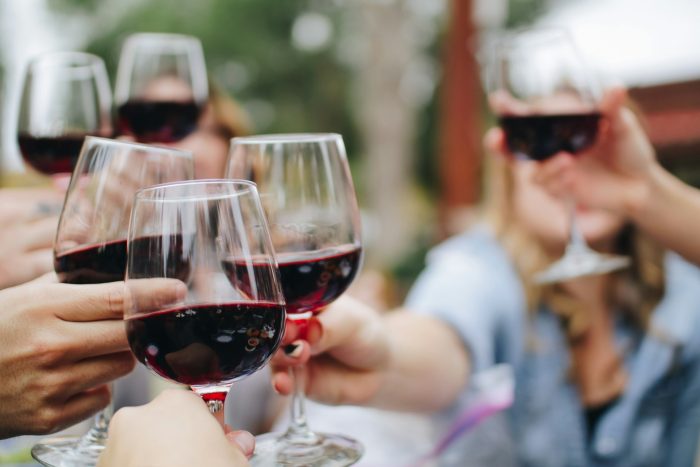{*Did you know you can write on Elephant? Here’s how—big changes: How to Write & Make Money or at least Be of Benefit on Elephant. ~ Waylon}
~
Alcohol is ubiquitous, readily available and consuming it is socially encouraged (in many parts of the world) yet alcohol consumption carries with it a slew of inherent risks and harms that aren’t openly spoken about in most mainstream conversations.
With the advancement and growth of the sober curious and mindful drinking movements, we are fortunately starting to see a subtle shift in the tides of normative alcohol culture; however, we are still a long way away from widespread knowledge and understanding of the inherent risks and harms associated with drinking alcohol.
Given the pervasive and entrenched nature of alcohol in many cultures coupled with its innate dangers, it seems reasonable that governing bodies would practice due diligence to clearly and adequately convey these dangers to those engaging with this substance. Unfortunately, this is simply not the case making how we engage with alcohol both an issue of consent and an issue of health equity.
Accurate information is intentionally being withheld and concealed purely for the purposes of profit. The collective is being kept in the dark when it comes to the inherent risks and harms that accompany alcohol consumption.
This is by design.
The alcohol industry or Big Alcohol deliberately perpetuates false and misleading information about the benefits of drinking alcohol, shamelessly promoting their products as healthy and safe while simultaneously contributing to the reinforcement of normative alcohol culture through beguiling and expensive marketing campaigns. Big Alcohol intentionally conceals the intrinsic dangers of booze while hoodwinking the collective through marketing messages and images that purport alcohol’s ability to foster connection, fun, community, and the overall enhancement of our lives.
Big Alcohol targets specific populations including women, young people, and heavy drinkers as these groups have been identified as “emerging markets” by alcohol companies. In the case of women, targeted marketing messages employ feminized and manipulative marketing tactics that promise empowerment, female connection, and equality as an outcome of consuming alcohol.
As if that weren’t bad enough, alcohol companies also organize corporate social responsibility events around topics like breast cancer and domestic violence, which is utter subterfuge and contributes not only to the malicious manipulation of women but also greatly contributes to the confusion and misinformation that exists around alcohol’s status as an inherently treacherous substance. Alcohol is one of the leading risk factors for breast cancer in women (after genetic and hereditary factors), so for an alcohol company to engage in a breast cancer awareness/fundraising event without acknowledging this connection stands to create a considerable amount of psychological confusion and cognitive dissonance.
Though given the relatively low rates of awareness of the causal link between alcohol and breast cancer risk, perhaps those attending such events are simply not aware of the levels of deception at play. However, that alcohol companies knowingly engage in these types of events is especially disturbing.
When it comes to global marketing regulations, the standards are generally quite lax and deviate significantly from country to country. In a largely unregulated environment, alcohol companies run amok with blatantly false and misleading marketing campaigns that ultimately perpetuate harm to their consumers and are not held responsible for these actions nor is it demanded of them that they tell the truth about alcohol.
In this confusing, misinformation-laden environment, it becomes nearly impossible to know and understand what is true about alcohol. Case in point: the false narrative that alcohol, specifically red wine, is “heart-healthy.” If there are any benefits to consuming red wine, they are substantially eclipsed by the harms that are present in that consumption.
In 2022, the World Heart Federation (WHF) unequivocally debunked the myth that alcohol is supportive of heart health by saying that “alcohol is not good for the heart” and that the safest and healthiest approach to alcohol is to consume none. The World Health Organization (WHO) has also clearly stated that no level of alcohol is safe for our health. Despite this clear, evidence-based declaration, the harmful myth of the health benefits of alcohol still persist.
When we do not have all the information, it becomes impossible to engage with something in a truly consensual, informed way. And when the clear, evidence-based information isn’t made readily available, it becomes an issue of health equity. Both are true when it comes to alcohol in the current climate.
According to the WHO, health equity “is the absence of unfair, avoidable or remediable differences among groups of people, whether those groups are defined socially, economically, demographically, or geographically or by other dimensions of inequality (e.g. sex, gender, ethnicity, disability, or sexual orientation). Health is a fundamental human right. Health equity is achieved when everyone can attain their full potential for health and well-being.” Using this definition as a jumping off point, it is clear that from the standpoint of access to clear information about alcohol, it is simply not being offered. The health equity issues also continue when it comes to access to treatment and care in the realm of addiction recovery.
Beyond savvy and unscrupulous marketing campaigns, the truth about alcohol is much darker and more menacing. Alcohol is a toxic, addictive, and psychoactive substance that was classified as a Group 1 carcinogen by the International Agency for Research on Cancer (IARC) in 1988. Alcohol is causally linked to at least seven different types of cancer, including breast, mouth, and colon cancer, is responsible for approximately three million deaths annually on a global scale, and is a negative causal factor in 200-plus diseases, injuries, and other health concerns. These statistics are significant yet not widely known by the average individual who is also likely to consume alcohol.
Taken directly from a January 2023 World Health Organization news release, the WHO had this to say about alcohol risk: “To identify a ‘safe’ level of alcohol consumption, valid scientific evidence would need to demonstrate that at and below a certain level, there is no risk of illness or injury associated with alcohol consumption. The new WHO statement clarifies: currently available evidence cannot indicate the existence of a threshold at which the carcinogenic effects of alcohol ‘switch on’ and start to manifest in the human body.”
In other words, there is currently no existing evidence or data that is able to clearly state that at a certain point or threshold, alcohol is no longer carcinogenic, which means that every alcoholic drink is carcinogenic. Period. The more you consume, the greater your risk for developing cancer. Conversely, the less you consume, the lower your risk.
In 2022, the Canadian Centre on Substance Use and Addiction (CCSA) provided an updated report for Canadians outlining new low-risk guidelines when it comes to drinking alcohol. Based on the latest research and data, these guidelines now state that in order to remain in the “low risk” category, individuals should consume no more than two standard drinks per week, which is a sharp departure from the previous guidelines (which suggested no more than 15 standard drinks per week for men or 10 standard drinks per week for women).
Clearly, change is needed in order to achieve an environment in which individuals can engage with alcohol in a consensual, informed way. In order to achieve a consensual environment where clear, accessible information about the risks and harms of alcohol consumption is as readily available as alcohol itself, several changes need to be implemented.
First, stronger global regulation policies around how marketing messages and campaigns are structured and disseminated are vital. The current environment is like the Wild West with few regulations and little to no oversight; this has to change. Not only do we need guardrails around the when and how of marketing campaigns but also around the what and the who—the language being used in campaigns needs to be clear and evidence-based and campaigns need to stop targeting more vulnerable populations purely for the purposes of profit.
In addition, every location that sells alcohol must also be required to provide clear information (in their local language) on the inherent risks and harms of alcohol and this should be a stipulation placed on any business wishing to sell alcohol.
It should be noted that while I work professionally as a sober coach and have been sober since 2016, my goal is not to coax everyone into sobriety. My goal is simply this: to have honest, accessible, evidence-based conversations about alcohol so that those who engage with it are educated on its risks and dangers and can make informed decisions and mitigate their risk. This is the foundation of consent and health equity when it comes to alcohol.
The current climate of misinformation is not conducive to individuals engaging with alcohol in a fully-informed or consensual way and much of the accurate, evidence-based information about alcohol exists within academic research papers or requires an advanced degree to read and understand. This should not be the case. Anyone and everyone who is ever exposed to alcohol should also be equally exposed to clear, understandable information so that they can make the best and most informed decisions for themselves, their bodies, and their lives.
We all deserve better.
~
{Please consider Boosting our authors’ articles in their first week to help them win Elephant’s Ecosystem so they can get paid and write more.}












Read 12 comments and reply